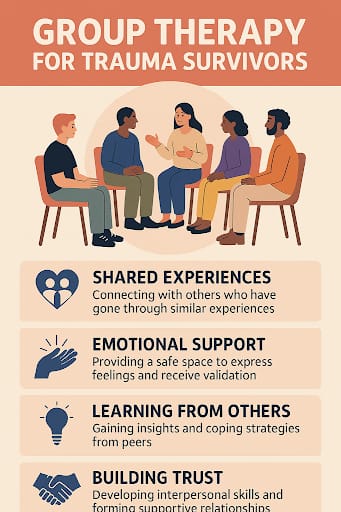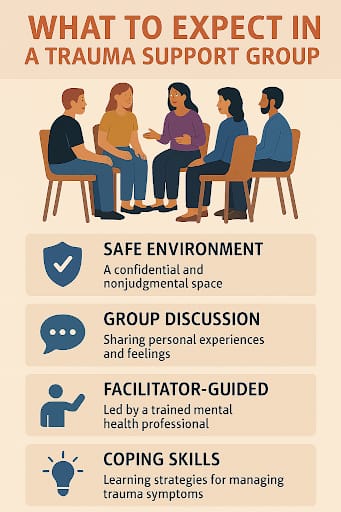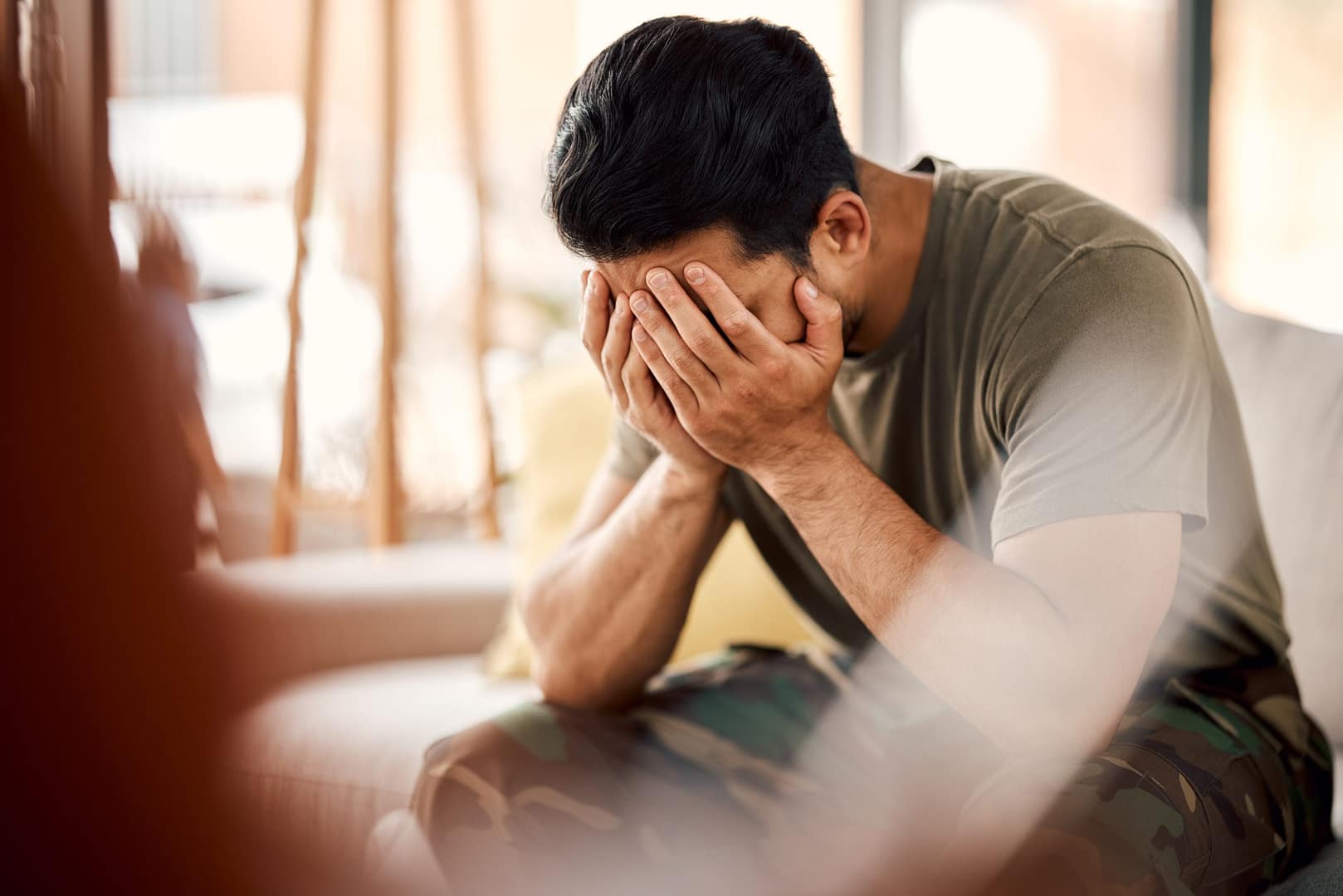
INTRODUCTION
Trauma can leave behind emotional scars that last a lifetime, but healing is possible — especially when you don’t have to do it alone. Group therapy can provide a safe and supportive environment for trauma survivors to share their experiences, learn from others, and take the first steps on the road to healing.
In a city as large and diverse as New York City, having the proper support can be the difference between struggling alone versus healing with a community. Whether you are experiencing childhood trauma, PTSD, or dealing with some catastrophic incidents that happened as an adult, NYC has many opportunities for group therapy that you can be part of.
In this blog, we will discuss the benefits of group therapy for trauma survivors, and what to expect in group therapy settings
What Is Group Therapy?
Group therapy for trauma is a type of therapy that brings people together who have experienced an event that resulted in trauma. Group therapy is structured and takes place in a safe, supportive environment, under the direction of trained therapists or counselors who are sensitive to the needs of trauma survivors.
Group psychotherapy provides opportunities for survivors to share their experiences and feelings with other individuals who can understand their struggles. Group therapy offers a community to survivors which minimizes the feelings of isolation after a traumatic event.
Sessions typically consist of sharing, discussions, therapeutic exercises, and skill-building related to developing healthy coping strategies. Specifically, there may be groups aimed at survivors of sexual assault, domestic violence, childhood abuse, combat trauma, or groups that are more generic.
Why Group Therapy Works for Trauma Survivors
Group therapy, in particular, is a wonderful option for trauma survivors because it addresses isolation, anxiety, depression, PTSD, flashbacks, guilt and emotional pain that accompany many traumatic events.
- Group therapy also directly addresses many of the challenges individuals face, including the emotional wounds.
- Whereas individual therapy is one-to-one, group therapy gives more people a chance to witness and display the sense of connection, belonging, and togetherness that the group is able to create.
- Being able to hear others personally share their stories, even just albeit brief elements of their stories, is incredibly validating.
- Individuals will realize that their responses are actually fairly normal, although stemming from an abnormal experience.
- It is important to be rewarded by being given a safe, non-judgmental space to be as open with thoughts and feelings that might be untouched in the five, ten or more years.
- Trauma-focused or trauma-informed groups might routinely have themes such as mindfulness, grounding, emotional regulation, and assertiveness.
- Just as importantly, being able to share that journey collectively through recovery, particularly in a safe environment, shows survivors that it is possible to heal and you can be part of the healing journey that is happening all around you.
Types of Group Therapy for Trauma
There are a number of different types of group therapy for trauma survivors to choose from based on their therapeutic needs.
- Psychoeducational groups inform participants about the impact of trauma on the brain and body, while providing coping strategies like mindfulness and emotional regulation.
- In contrast, support groups focus on shared experience and provide emotional support for each other by listening and encouraging group members.
- This space builds community and provides support in the aftermath of their own trauma by processing or discussing their experience through a community lens.
- However, for those seeking deeper healing, licensed professionals run process-oriented therapy groups that help participants develop understanding of how trauma impacts their relationships, sense of self, and emotions; and communication for healing purposes, fostering transformation and moving toward finding purpose.
It is also important to consider specialized groups that use evidence-based modalities like Cognitive Behavioral Therapy (CBT), Eye Movement Desensitization and Reprocessing (EMDR), and Dialectical Behavior Therapy (DBT) between other forms of trauma and recovery-inhabiting specialized therapy groups.
What to Expect in a Trauma Setting Group

Walking into a trauma group for the first time can be anxious but knowing what to expect may help with those initial jitters.
- Trauma groups are meant to create a safe and supportive environment where participants can begin healing in their own time.
- To establish that safety and support, facilitators, who are typically licensed therapists, communicate clear guidelines regarding confidentiality, respect, and personal boundaries.
- Sharing is always voluntary; participants are never compelled to talk about their trauma until they feel safe to do so.
- Sessions are routinely structured to include group check-in, a specific topic or therapeutic activity, and a reflection or closing moments.
- Each therapist facilitates the group’s discussion and intervenes when a participant is in need of emotional support as they experience intense feelings.
- Even though group members come from many different places in life, their commonality of trauma provides an understanding and connection that can help a trauma survivor to heal, grow.
How to Get Started
If you’re thinking about beginning group therapy for trauma in NYC, you may be intimidated about taking the first steps, but it doesn’t need to be!
- First, consider what type of group you may need. Are you looking for general trauma support, or a group with a specific focus, like domestic violence or PTSD? After you’ve considered what kind of group you are looking for, take a look at your budget/insurance.
- Most group therapy programs will begin with an intake appointment with a therapist, to go over your history and help you to decide which group fits your needs.
- Don’t feel pressured to commit to a group directly, it is a good idea to try out a couple of groups before determining which is right for you.
- Most importantly, give yourself some grace. Trauma is rarely healed overnight, and it’s perfectly fine to take breaks, explore different groups, or supplement group therapy with individual counseling, while you find what works best for you.
Final Thought
Group therapy can be a powerful healing modality for trauma survivors, providing community, compassion, and understanding from individuals who otherwise would not have the opportunity to connect.
- If you’re looking for emotional validation, skills to cope with trauma, or just a safe place to be and heal, there is a group for that.
- In any form of therapy, healing your trauma will take time.
- Healing isn’t achieved overnight; with the right people in your life, it can absolutely happen. You deserve to heal, have hope, and work towards feeling connected.
Reference
- Malhotra, A., Mars, J. A., & Baker, J. (2024b, October 29). Group therapy. StatPearls – NCBI Bookshelf. https://www.ncbi.nlm.nih.gov/books/NBK549812/
- Zona, K., Huang, H., & Spottswood, M. (2024). Implementing group therapy for posttraumatic stress disorder within a primary care setting: A pilot study. Journal of Affective Disorders Reports, 19, 100856. https://doi.org/10.1016/j.jadr.2024.100856
- Yalch, M. M., Moreland, M. L., & Burkman, K. M. (2022). Integrating process and structure in group therapy for survivors of trauma. European Journal of Trauma & Dissociation, 6(3), 100272. https://doi.org/10.1016/j.ejtd.2022.100272
- Group interventions for trauma. (n.d.). https://www.agpa.org/home/developing-healthy-communities/group-interventions-for-trauma
- Shapiro, F. The Role of Eye Movement Desensitization and Reprocessing (EMDR) Therapy in Medicine: Addressing the Psychological and Physical Symptoms Stemming from Adverse Life Experiences. The Permanente Journal, 18(1), 71. https://doi.org/10.7812/TPP/13-098
- Lubin, H., Loris, M., Burt, J., & Johnson, D. R. (1998). Efficacy of psychoeducational group therapy in reducing symptoms of posttraumatic stress disorder among multiple traumatized women. American Journal of Psychiatry, 155(9), 1172–1177. https://doi.org/10.1176/ajp.155.9.1172






